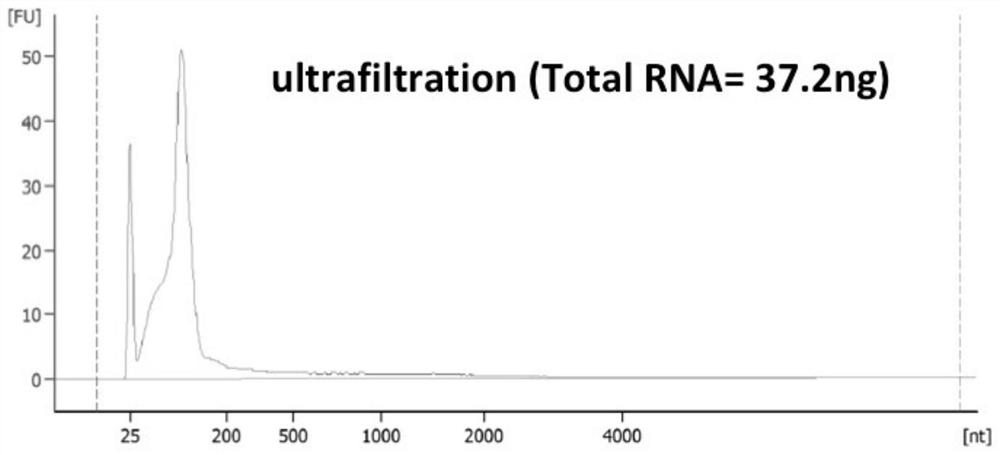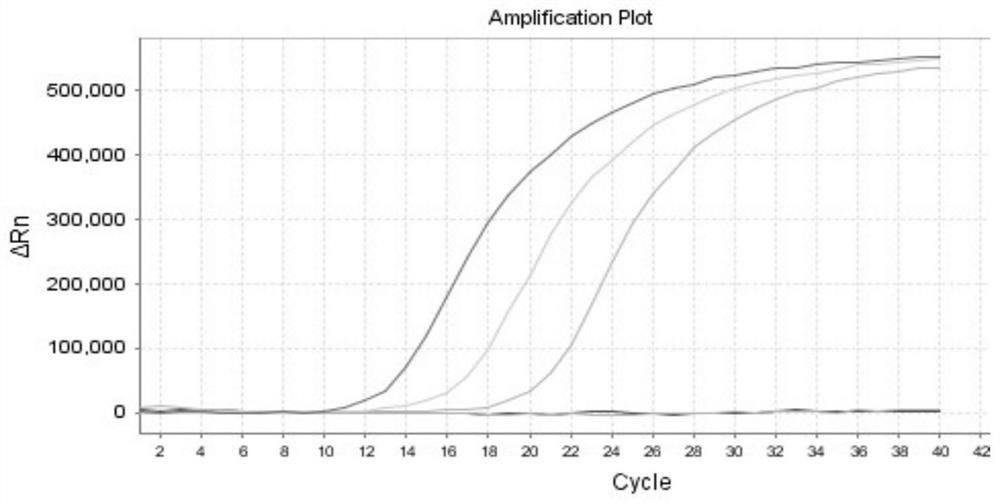Biomarkers and detection kits for bladder cancer diagnosis and recurrence monitoring
A biomarker and kit technology, applied in the fields of biotechnology and medicine, can solve the problems of unsatisfactory sensitivity and specificity, and achieve the effect of avoiding pain and high sensitivity
- Summary
- Abstract
- Description
- Claims
- Application Information
AI Technical Summary
Problems solved by technology
Method used
Image
Examples
Embodiment 1
[0087] The separation method of embodiment 1 urine vesicle
[0088] 1. UC method: 40ml human morning urine sample, centrifuged at low speed to remove cells, centrifuged at 17000g for 30min to remove cell debris and apoptotic bodies, etc., ultracentrifuged at 100000g for 2h, removed supernatant, resuspended in PBS and centrifuged again at 100000g for 2h, resuspended in 100ul PBS Vesicles were obtained from the suspended pellet.
[0089] 2. Ultrafiltration method: After the sample is thawed, centrifuge at 17000×g for 30min; after centrifugation, the sample passes through 0.45um0.22um in turn; prepare two ultrafiltration centrifuge tubes, and take 15ml of the sample filtered by the filter membrane in each ultracentrifuge tube, Centrifuge at 4500×g for 15 minutes at room temperature; carefully remove the centrifuge tube, discard the liquid at the bottom of the ultrafiltration tube, then resuspend the retentate with 5ml of the remaining filtered urine and 10ml of 1XPBS, invert 3-4 ...
Embodiment 2
[0094] Example 2 Screening of differentially expressed genes
[0095] In order to screen urinary vesicle markers related to bladder cancer, 15 cases of bladder cancer patients (including newly diagnosed bladder cancer patients and patients with postoperative recurrence) and controls (normal subjects and patients without postoperative recurrence) were selected. The morning urine should not be less than 50ml, and the vesicles in the urine were separated by classical ultracentrifugation method and RNA was extracted, and the obtained RNA was subjected to miRNA and long RNA library sequencing (including mRNA, LncRNA and CircRNA). The obtained data were analyzed by bioinformatics, and the differentially expressed RNAs in bladder cancer patients and controls were compared, and correlation analysis was performed with the miRNA sequencing and transcriptome sequencing data published in TCGA (https: / / cancergenome.nih.gov / ), The screened differential RNAs from urine vesicles derived from ...
Embodiment 3
[0098] Example 3 Verify the primers of selected gene markers by real-time fluorescent PCR
[0099] 1. Design and synthesis of primers and probes
[0100] Primers and probes for 11 bladder cancer markers and 3 internal reference genes listed in Table 1 were designed in combination with Primer Premier 5 software and Primer-BLAST (NCBI). The design principles are as follows: 1) The amplified fragment is less than 150bp; 2) At least one primer spans the exon-exon boundary; 3) The Tm value of the probe is at least 5°C higher than that of the primer. The designed primers and probe sequences were synthesized by the company, in which the 5' end of the probe was labeled with FAM group, and the 3' end was labeled with BHQ1.
[0101] Table 2 Bladder cancer markers and primer probe sequences (SEQ ID NO: 1-42) of internal reference genes
[0102]
[0103]
[0104] *:Reference gene.
[0105] 2. Reverse transcription and qPCR detection
[0106] Using Takara's PrimeScript TM RT rea...
PUM
| Property | Measurement | Unit |
|---|---|---|
| Sensitivity | aaaaa | aaaaa |
| Sensitivity | aaaaa | aaaaa |
| Sensitivity | aaaaa | aaaaa |
Abstract
Description
Claims
Application Information
 Login to View More
Login to View More - R&D
- Intellectual Property
- Life Sciences
- Materials
- Tech Scout
- Unparalleled Data Quality
- Higher Quality Content
- 60% Fewer Hallucinations
Browse by: Latest US Patents, China's latest patents, Technical Efficacy Thesaurus, Application Domain, Technology Topic, Popular Technical Reports.
© 2025 PatSnap. All rights reserved.Legal|Privacy policy|Modern Slavery Act Transparency Statement|Sitemap|About US| Contact US: help@patsnap.com



